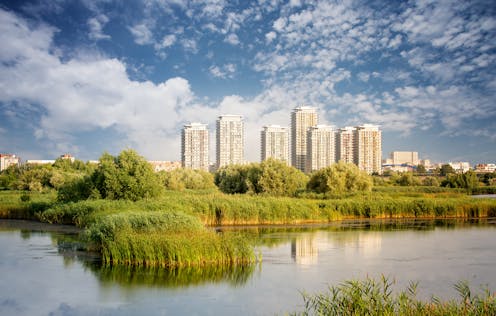Source: The Conversation (Au and NZ) – By Jack Marley, Environment + Energy Editor, UK edition
Your home was probably designed for a climate that no longer exists.
As long as humanity continues to burn fossil fuel, padding the heat-trapping blanket of gases in Earth’s atmosphere, the weather will become more volatile. Without an urgent transformation, our built environment will buckle under the mounting strain of heatwaves, floods and storms.

It’s estimated that close to 7 billion people will live in urban areas in 2050. Climate scientists convened by the United Nations have said that global emissions of greenhouse gas must be net zero by then – in other words, equal to the rate at which they are removed by ecosystems and (still immature) technology.
For people to thrive in a more dangerous world, cities will need to look very different.
This roundup of The Conversation’s climate coverage comes from our weekly climate action newsletter. Every Wednesday, The Conversation’s environment editor writes Imagine, a short email that goes a little deeper into just one climate issue. Join the 30,000+ readers who’ve subscribed.
Houston is a city of 2.3 million people in southeast Texas, US. Heavy rainfall caused widespread flooding here last week.
How much carnage storms cause in a warming world is only partly a function of the climate. Equally important is the design of a city says Richard B. “Ricky” Rood, a professor emeritus of climate, space and engineering at the University of Michigan.
Read more:
Houston’s flood problems offer lessons for cities trying to adapt to a changing climate
“Pavement is a major contributor to urban flooding, because water cannot be absorbed and it runs off quickly. The Houston area’s frequent flooding illustrates the risks,” he says.
“[Houston’s] impervious surfaces expanded by 386 square miles between 1997 and 2017, according to data collected by Rice University. More streets, parking lots and buildings meant more standing water with fewer places for rainwater to sink in.”

Trong Nguyen/Shutterstock
What Houston and other concrete-covered cities need is less grey and more green, says Lund University’s Björn Wickenberg. Wickenberg is a PhD candidate who researches nature-based solutions to problems like urban flooding.
“My neighbourhood has three dams for storing stormwater in the event of extreme rain. These help slow the water instead of overburdening the city’s underground water sewage system, which would increase the risk of flooding.”
That’s not all they do. Wickenberg describes how these storm-water dams have created ponds that serve as larders for herons and ice-skating facilities when they freeze. On a much bigger scale, wetland habitats are being considered to buffer coastal cities from rising seas.
Read more:
Slow down and embrace nature – how to create better cities when the pandemic is over
“‘Sponge cities’, an approach first introduced in China in 2013, are a nice example of this in practice,” say engineer Faith Chan (University of Nottingham) and geographer Olalekan Adekola (York St John University).
“The idea of a sponge city is that rather than using concrete to channel away rainwater, it is best to work with nature to absorb, clean and use the water. So, much like a sponge, the cities are designed to soak up the excess storm water without becoming over-saturated.”
Read more:
As sea levels rise, coastal megacities will need more than flood barriers
Speculation preventing adaptation
Saudi Arabia had a different vision of a 21st-century city.
The Line, as the name suggests, would have been entirely linear: a 170-kilometre gash in the desert running from the Red Sea and clad in reflective material. A private police force and autonomous transport system aside, The Line’s planners had few answers to how 1.5 million people were going to live well in an artificial channel exposed to 50°C temperatures, says David Murakami Wood, a professor of critical surveillance and securities studies at the University of Ottawa.
“Who was going to want to live at the far end of a 170-kilometre long parallel terrace from which your only means of exit was an ‘intelligent’ train system?” he asks.
“And how was security going to be managed for a place which promised freedom and legal systems compatible with international human rights norms in one of the most authoritarian nations in the world, both internally and externally?”
Saudi Arabia plans to scale back The Line to a measly 2.4km by 2030. Woods doubts whether the scheme was much more than a public relations exercise, designed to raise speculative foreign investment. But he argues The Line indicates a wider failure of the capitalist imagination to devise a desirable place for people to live in a rapidly changing climate.

Choi Yurim/Shutterstock
Designing a resilient city is one thing. To turn that blueprint into a real place, countries have to contend with a market-driven system of planning that prioritises protecting assets at the expense of everything else.
Sustainable development expert Lucien Georgeson and earth system scientist Mark Maslin (both at UCL) compared public spending on climate adaptation in megacities within rich and poor nations. No country is spending enough to adapt to climate change. But Georgeson and Maslin revealed that New York City spends £190 (US$260) on it per person, while Ethiopia’s capital Addis Ababa – where climate change is a far scarier prospect – can afford less than £5 (US$7).
Read more:
COP26: countries are not spending nearly enough on adapting to climate change
“It seems the amount spent on climate adaptation is driven more by the amount of wealth at risk rather than the number of vulnerable people,” they say.
Read more:
Climate change adaptation in global megacities protects wealth – not people
![]()
– ref. A ‘sponge city’ may be your home in 2050 – https://theconversation.com/a-sponge-city-may-be-your-home-in-2050-229565










